In Search of the Niinja (21 page)
Read In Search of the Niinja Online
Authors: Antony Cummins

A minor puzzle presented in the
Gunpo Jiyoshu
manual is that the author places portable watch towers in the ninja section. The question is, were these towers used by the shinobi or used against them? The answer is found in the
Hu-ling Ching
where it states that ‘you should use watch towers and capture living agents.’ This would mean that these portable watchtowers were positioned along army lines and used to search for movements of the shinobi as they tried to pass through enemy lines. Of course, this is only a daytime measure and that there was a need for listening scouts at night. However, it is an art used in Chinese warfare, and interestingly, both are connected with the ‘living agent’. In the
Shoninki
a ‘living agent’ is a ninja, thus making the skill set and linguistics identical in both countries.
Not only shinobi manuals, but also other Japanese documents talk of using pots, barrels and flotation devices to cross water, and whilst this may be universal, it does appear in the Chinese texts: ‘Use bamboo and rope and pass over water in pots.’
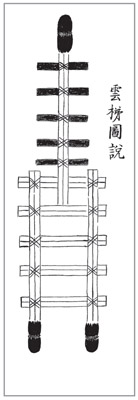
The Japanese version of the Cloud Ladder.

A movable watchtower, taken from the Japanese
Gunpo Jiyoshu
manual.
However, both Chinese and Japanese manuals share a selection of complex water bridging tools, some of which are ninja and some of which are more common military practice. Shinobi bridges tend to be smaller than their Chinese counterparts, even if they share a linguistic connection.
The Six Secret Teachings
says: ‘Unorthodox technical skills are the means by which to cross deep waters and to ford rivers. For crossing moats and ditches, there is the flying bridge. One section is fifteen feet wide and more than 20 feet long.’
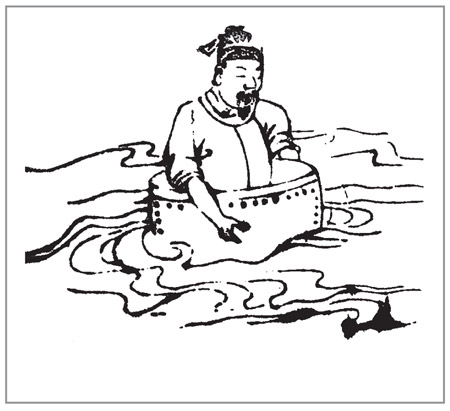
The Chinese art of using pots to float across rivers.
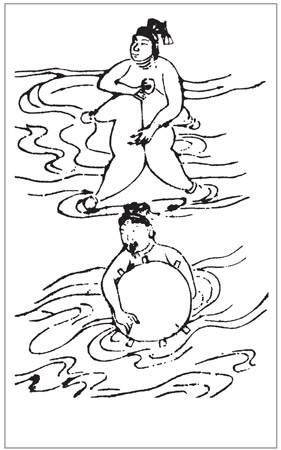
The use of inflatable leather floats is shared by the Chinese and Japanese.
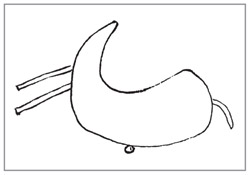
The leather floating aid in the Japanese
Shinobi Hiden
manual and which can be found in other ninja manuals.
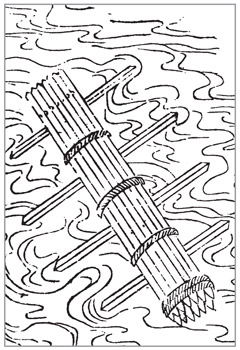
The Chinese version of the cat-tail raft.
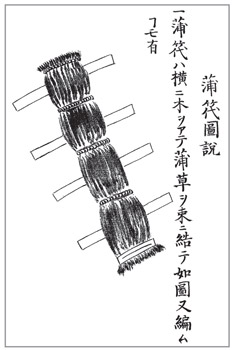
As can be seen, the cat-tail raft which appears in the
Bansenshukai
ninja manual is identical to its Chinese counterpart.
The Japanese and the Chinese also share the skill of using animal skins as flotation buoys, and whilst this skill is a worldwide phenomenon, the similarities between the Chinese manuals and the ninja scrolls cannot be ignored.
Sun Tzu’s chapter ‘Incendiary Attacks’ can be seen as the foundation of the understanding of the use of conflagration in the ancient eastern world. It spawned multiple written expansions on the use of fire tools and their development, some of which were produced by active generals and some of which were produced by theorists. Chinese fire skills without doubt came to Japan, as China is the source of all explosive warfare skills. How much did the Chinese influence the Japanese ninja?
Whilst ninja-like stealthy infiltrations in China do not prove a direct connection with the ninja, the methods and tactics used by both the Chinese and the Japanese are very similar. The
Ts
’
ui-wei Pei-cheng-lu
describes a form of agent known as the
Yu Ping
and instructs that they should ‘steal enemy foodstuffs and burn provisions but should not get bogged down in combat’. The
Koa Chiung
advises the secret despatch of agents ‘to exploit favourable winds to set fires and then wait until they rebuild their structures and we burn them again…’
Perhaps the earliest entry of ninja-like figures in Chinese history are the
T
’
ai-pai Yin-ching
’
s
‘Incendiary Thieves’ or
Huo Tao
. The resemblance to the ninja borders on the identical:
Pick a man who is courageous and nimble, whose speech and clothes are the same as the enemy. After filching their passwords, he should be dispatched to sneak into the enemy’s encampment bearing fire and burn their stores and provisions. When the fire starts he can then exploit the confusion and get out.
The only difference to this in the
Bansenshukai
is that the ninja should attempt to stay hidden during the confusion so he is not killed by his own side on exit. The
Ts
’
ao-lu Ching-lueh
again:
Select clever, skilled warriors who are strong enough to oppose 100 men, have them pretend to be merchants or traders and enter the city long before any action develops. Then when your own soldiers reach the city walls, they [the agents] can respond by burning the people’s dwellings in the middle of the night. When the flames illuminate the entire area, they should falsely yell out that the enemy has penetrated the city. The people and the soldiers will be totally confused and you can exploit the opportunity and achieve your objective.
The ‘false cry’ is a common feature in shinobi manuals. A shinobi might infiltrate a house and cry ‘thief’ simply to see the enemy’s reactions and defence methods. Misdirection was often used by the shinobi. The
Bansenshukai
talks of sending troops to fight and cause distraction whilst individuals or teams of shinobi use the diversion to infiltrate a position. Its mirror can be found in Sung’s use of shinobi-like troops in ancient China: ‘Sung had his soldiers ascend the city walls carrying burning torches and his elite troops secretly worked their way out through the siege line to set fire to the enemy’s encampment.’
Of all the ninja manuals, it is the
Shoninki
that most clearly quotes from
The
Art of War
in relation to fire. The first of these connections is the use of the ‘Lunar Lodges’ or ‘Mansions’, which famously originated with Sun Tzu. Lunar Lodges or Mansions are 28 theoretical divisions in the night sky along the Elliptic Plane stretching from pole to pole. These divisions are not equal and the origin of their names has been lost. However, the Chinese (and the rest of Asia) used this division of 28 to map the moon’s progress through the lunar month. As we can see from Fujibayashi and Natori’s use of Sun Tzu’s incendiary advice, a ninja would have to understand when the moon was in each lodge. The Lunar Lodges were used to understand dates, direction and time, a skill which a shinobi required.
The Art of War
:
As for the day [to set ablaze], it is when the moon is in the lunar lodges of chi, pi, yi, or chen. When it is in these four lunar lodges/mansions wind will arise [therefore it is good to set a fire].
The
Shoninki
ninja manual states that tradition says:
It is said when the moon crosses the mansion lines of the following:
1 Ki the Winnowing Basket.
the Winnowing Basket.